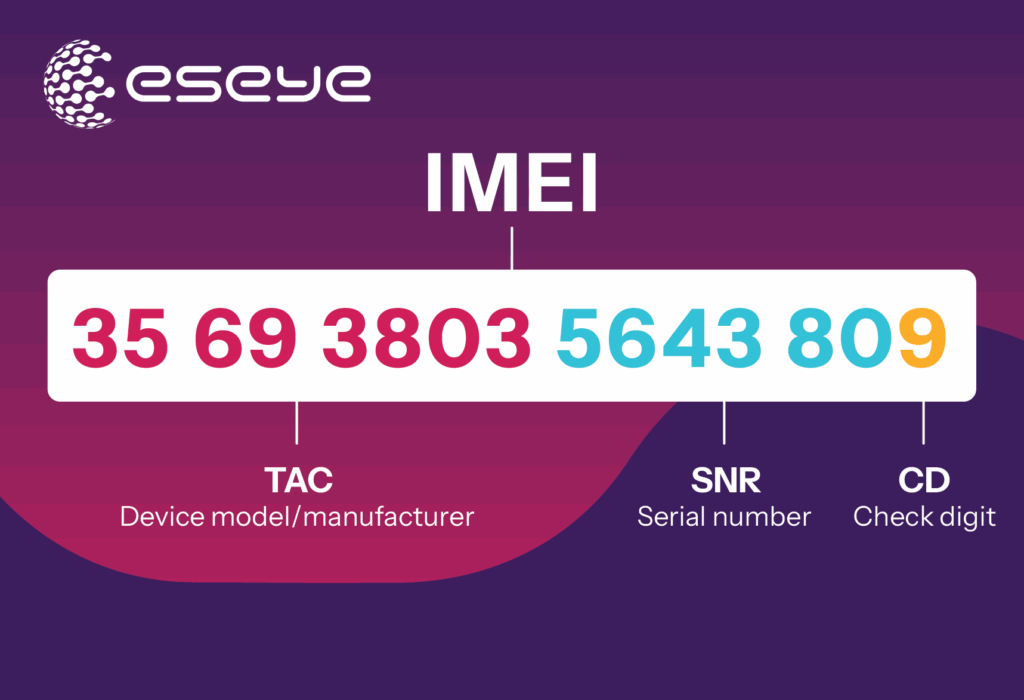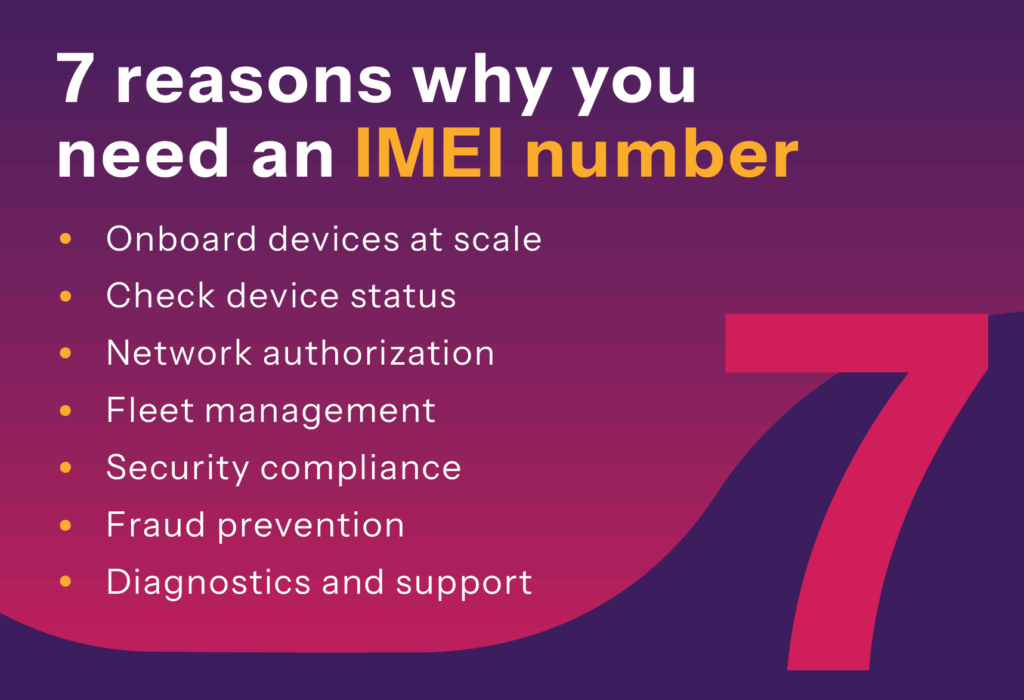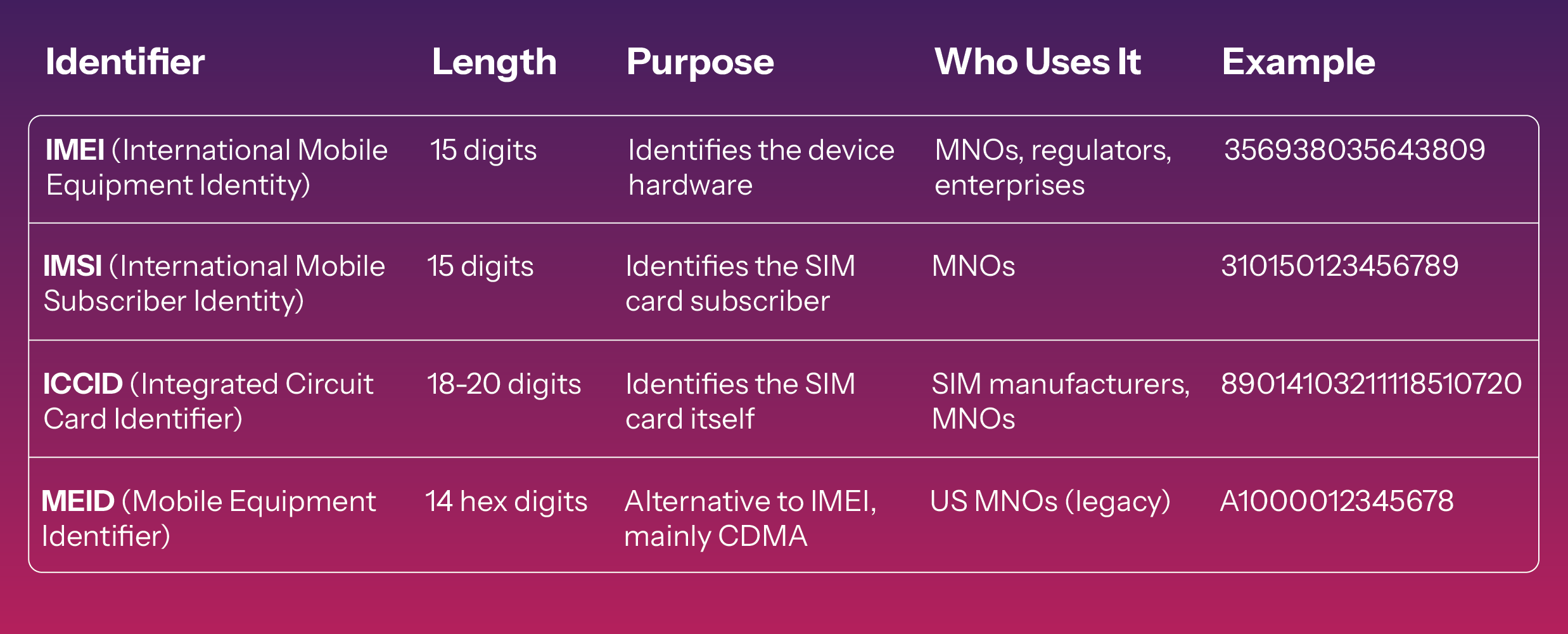Quick Summary
An IMEI (International Mobile Equipment Identity) number is a unique 15-digit code that identifies every cellular-connected device worldwide. Think of it as your IoT hardware’s digital passport. You’ll need it to check device status, unlock mobile network operator (MNO) services, and ensure your IoT device is authorized on global networks.
Understanding IMEI number
What is an IMEI number?

Every cellular IoT device — from smart vending and EV chargers to medical equipment and asset tracking — comes with a unique IMEI number. It’s not random: it’s a global standard used by mobile network operators (MNOs) and regulators to identify and authenticate devices. Unlike a SIM card, which links to a subscription, the IMEI links directly to the device hardware itself.
That makes the IMEI invaluable for enterprises because it enables:
- Authorizing devices on networks: MNOs use IMEIs to confirm whether hardware is approved and compliant.
- Managing large-scale fleets: IMEIs provide traceability across thousands of devices in different geographies.
- Security and fraud prevention: Blacklist checks stop counterfeit or stolen devices from being activated.
- Diagnostics and lifecycle control: IMEIs are used in APIs and IoT management platforms to query device status, logs, and activity.
In short: if an IoT device connects to a mobile network, its IMEI is the passport that gets it through the gate.
Structure of an IMEI number
An IMEI is usually 15 digits long, structured into segments:
- TAC (Type Allocation Code): The first 8 digits identify the device model and manufacturer.
- Serial Number: The next 6 digits make each device unique.
- Check Digit: The final digit validates the IMEI using the Luhn algorithm.
For example: 356938035643809.
- 35693803 → Device model/manufacturer (TAC)
- 564380 → Serial number
- 9 → Check digit
This structured approach ensures no two devices share the same IMEI.
Importance of an IMEI number
Why does it matter? Because mobile networks trust IMEIs to validate devices. Without a valid IMEI:
- Your device won’t connect to MNO services.
- Counterfeit or unauthorized IoT devices can be blocked.
- Device lifecycles can’t be properly managed.
For IoT, this becomes even more critical. Imagine deploying thousands of connected sensors worldwide. IMEIs provide the traceability and compliance needed to ensure every device can operate securely and at scale.
Difference between IMEI and MEID
IMEI isn’t the only identifier. Some networks, especially in the US, use MEID (Mobile Equipment Identifier).
- IMEI: 15-digit number, standardized globally.
- MEID: 14-digit hexadecimal number, once used on CDMA networks. Now largely obsolete, and rarely relevant for new IoT deployments.
While some legacy CDMA networks used MEID, today IMEI is the universal standard and the one that matters for virtually all modern IoT devices.
How to find your IMEI number
Ways to find the IMEI number on your device
Unlike consumer phones, IoT devices often don’t have screens, so you’ll need to use other methods:
- Via MNO records: If the device has already been provisioned on a network, your carrier or connectivity provider may be able to supply the IMEI as part of its device inventory.
- On the device label: Most IoT modules, routers, or gateways include the IMEI printed on a sticker or metal plate, often near the SIM slot or under a removable cover.
- In the device firmware or software interface: Many IoT devices expose the IMEI in their management console, web UI, or via AT commands. For example, running the AT+CGSN command on a cellular module will return the IMEI.
- Through an IoT connectivity management platform: If your devices are enrolled in an IoT connectivity management platform, the IMEIs can usually be retrieved programmatically and exported as a list, giving you a full device inventory at scale.
- On the packaging or datasheet: Manufacturers often include the IMEI on product packaging or in the device’s technical documentation.
Uses of the IMEI number
Why you might need your IMEI number

In IoT, the IMEI isn’t just an identifier — it’s a control point for security, compliance, and lifecycle management. Enterprises rely on IMEIs for several reasons:
Device onboarding at scale: When activating thousands of devices across different regions, IMEIs provide a reliable way to register and validate each unit.
Device status: IMEIs inform you whether or not the SIM is linked to a device.
Network authorization: Mobile operators use IMEIs to decide whether a device is permitted to connect. Without a valid IMEI, your IoT device won’t get service.
Fleet management: Enterprises track IMEIs to monitor deployed devices, manage warranties, and ensure hardware accountability.
Security compliance: IMEIs are logged in GSMA and carrier databases, helping enterprises prove their devices are genuine and compliant.
Fraud prevention: If devices are stolen in transit or during deployment, IMEIs can be blacklisted to block unauthorized network access.
Diagnostics and support: Technical teams often request IMEIs when troubleshooting connectivity issues or escalating with carriers.
In short: the IMEI helps enterprises keep control of sprawling IoT estates. Without it, there’s no way to ensure that every device in the field is real, authorized, and functioning as expected. In many IoT platforms, including API-driven ones like Infinity, the IMEI acts as the lookup key for retrieving device details, activity logs, and connectivity status automatically which eliminates the need for manual checks.
How to check your IMEI for device status
You can enter your IMEI into online databases provided by MNOs or GSMA services. These checks reveal if your device is:
- Active and authorized.
- Under warranty.
- Reported as lost, stolen, or blacklisted.
For IoT, this reduces costly deployment errors. Knowing the status upfront prevents dead-on-arrival devices in the field.
Eseye’s Infinity Connectivity Management Platform shows your device status and signals whether the SIM is Linked or Unlinked to the device:
- Linked – the SIM has an IMEI assigned.
- Unlinked – the SIM does not have an IMEI assigned.
With our enterprise-grade IoT management APIs, IMEI checks can be automated at scale to let you instantly verify thousands of devices across multiple carriers and regions in one request.
Understanding IMEISV and its importance
Alongside IMEI, you may see IMEISV (International Mobile Equipment Identity Software Version). This adds two digits to indicate the device’s software version.
Why it matters:
- Operators can confirm you’re running an approved software build.
- Enterprises can monitor device fleets to ensure they’re patched and compliant.
- It adds another layer of assurance for security-sensitive deployments.
IMEISV keeps devices accountable, not just at the hardware level but also in terms of software integrity.
IMEI blacklisting: What Enterprises need to know
What is IMEI blacklisting in IoT?
In the enterprise world, blacklisting isn’t about losing a single handset — it’s about preventing compromised, counterfeit, or stolen devices from entering your IoT estate. A blacklisted IMEI is flagged in global or carrier databases as unauthorized. Once listed, that device cannot connect to most mobile networks.
For IoT leaders, that means blacklisting protects your deployment from risk, fraud, and regulatory non-compliance.
Why blacklist checks matter for Enterprises
When deploying thousands of devices worldwide, even a handful of blacklisted units can derail operations. Imagine rolling out smart meters, medical devices, or logistics trackers only to discover some can’t connect because their IMEIs are invalid or blocked. That translates directly into wasted time, sunk costs, and lost trust.
By checking IMEIs before devices are activated, enterprises can:
- Protect their brand reputation with reliable, verified deployments.
- Prevent stolen or counterfeit hardware from being provisioned.
- Ensure regulatory compliance across multiple countries.
- Avoid downtime caused by blocked or unauthorized devices.
How Enterprises check IMEI blacklist status
Instead of manual lookups, enterprises use IoT connectivity management platforms and APIs to automate blacklist checks at scale.
Lifecycle monitoring: Continuous checks flag devices that become blacklisted after deployment.
Programmatic verification: APIs query carrier and GSMA databases in real time.
Batch validation: Enterprises can upload IMEI ranges to confirm status before shipment or activation.
Resolving a blacklist issue in IoT
If devices are incorrectly blacklisted, resolution usually involves:
- Confirming with the mobile network — errors can occur in large-scale deployments.
- Providing supply-chain documentation — proof of purchase or manufacturer records.
- Requesting removal via authorized channels — only the mobile network that flagged the IMEI can remove it.
Proactive validation at onboarding avoids most of these headaches. We recommend that enterprises build blacklist checks into their IoT deployment workflows from day one.
IMEI vs IMSI vs ICCID vs MEID: What’s the difference?
This table clarifies a common source of confusion. IMEI = device, IMSI = subscriber, ICCID = SIM, MEID = legacy device ID.

IMEI Frequently Asked Questions (FAQs)
IMEI in the bigger picture
At first glance, an IMEI looks like just another technical code. In reality, it’s a cornerstone of mobile security, compliance, and device management.
For individuals, it protects your phone and unlocks mobile services. For enterprises, it underpins IoT at scale — tracking, authenticating, and securing entire fleets of devices worldwide.
At Eseye, we help businesses put IMEIs to work. They’re more than consumer identifiers: they’re the key reference point in how enterprises query, monitor, and safeguard IoT deployments. Combined with intelligent connectivity management, IMEIs give you the foundation to scale IoT with confidence.
In a connected world, an IMEI isn’t just a number. It’s your device’s ticket to secure, resilient connectivity.
Eseye brings decades of end-to-end expertise to integrate and optimise IoT connectivity delivering near 100% uptime. From idea to implementation and beyond, we deliver lasting value from IoT. Nobody does IoT better.
In this article
